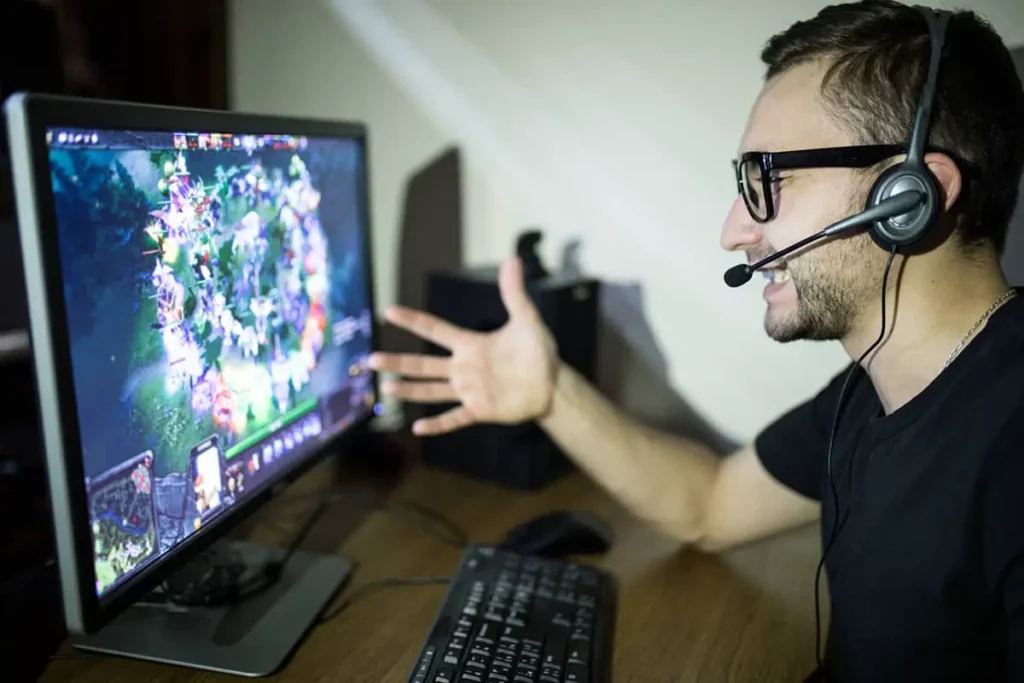After forking over thousands of dollars for a high-end gaming PC, you understandably expect a smooth gaming experience. Unfortunately, PCs are fickle machines. Regardless of the cost of your PC, you’ll always have some hoops to jump through to achieve the ideal gaming experience.
Causes for low frames on a high-end PC include CPU or GPU bottlenecks, insufficient RAM, out-of-date drivers, and non-optimized Windows settings. Each of these causes has simple solutions, but some of them come with a significant price tag.
I’ll explore solutions to each of the above-listed issues in this article. Additionally, I will dive into some other potential causes of a poor gaming experience.
1. Mismatch Between GPU and CPU
Your PC has two major factors for determining your framerate: the graphics processing unit (GPU) and the central processing unit (CPU). These two pieces of hardware work together to determine how many frames per second (FPS) your PC can handle in-game. A mismatch in power between these two pieces is a common cause for low FPS.
Low FPS from a GPU and CPU power mismatch is called a bottleneck, and they are probably the most common cause of low FPS. A bottleneck means either your GPU or CPU can’t process things at the same rate as your higher-end hardware. In other words, your CPU can’t keep up with your GPU or vice versa.
Unfortunately, fixing bottlenecks is not straightforward. Some games rely almost entirely on your GPU with minimal CPU input, while others are equally intensive on both components or even depend mostly on CPU performance. Not all games will be affected by a bottleneck in the same way.
Identifying the Cause of Your Bottleneck
Before we can hop into fixing a bottleneck, we need to identify whether your CPU or GPU is the cause of your bottleneck.
Recent games tend to be more CPU-dependent. A CPU-dependent game means your CPU will take on most processing power. In this case, upgrading your CPU will alleviate your bottleneck.
As a game goes further into its lifecycle, the processing load tends to switch from the CPU to the GPU. Therefore, a GPU upgrade will be more likely to fix bottlenecks when it comes to more established games.
That’s all fine information, but I can still hear you asking, how do I identify the bottleneck? Don’t worry. I have some clear steps
How to fix your PC bottleneck.
- Open the game that is giving you a low FPS. Make sure you’re not running other intensive programs at the same time.
- Open task manager. To open Task Manager, search “Task Manager” in your Windows search bar and select Task Manager from the Start menu.
- Check the percent load on your CPU and GPU. You’ll see your major PC component loads in percentages at the top of the “Processes” tab in the task manager. If either your CPU or GPU or at or close to 100%, you’ve identified the cause of your bottleneck.
The cause of your bottleneck is the PC component that has reached a 100% load. To keep the example clear, let’s say your CPU is at 100%.
A CPU at 100% means your CPU is processing at its maximum capacity but cannot keep up with the processing power of your GPU. If your GPU is the one at 100%, it’s the other way around: your GPU can’t keep up with your CPU.
Whether your GPU or CPU is the cause of the bottleneck, you’ll have the same result—unacceptably low FPS. So, how can you fix your bottleneck? Assuming upgrading your PC components is a last resort, there are a few less costly potential fixes.
Three Ways To Fix a CPU Bottleneck
If you’re experiencing a CPU bottleneck, there are a few methods you can try before upgrading.
- Increase your game resolution. Increasing your resolution may sound counterintuitive. However, upping your graphic settings in-game will shift a portion of the load from your CPU to your GPU. Most games will allow you to change your resolution in the game settings.
- CPU overclocking. Overclocking your CPU will allow your CPU to take on more processing power. However, some CPUs don’t support overclocking. Additionally, overclocking can be harsh and complicated to set up on your CPU.
- Lower settings that affect the CPU. Different settings have different effects on the CPU and GPU. We can take advantage of this information by targeting and lowering CPU-centered settings. A rule of thumb in PC gaming is anything that adds more objects to the screen will increase the load of the CPU. An example of a CPU-bound setting is render distance.
If none of the above-listed solutions fixes your bottleneck, it may be time to look into a CPU upgrade.
Three Ways To Fix a GPU Bottleneck
Like a CPU bottleneck, it is possible to fix your GPU bottleneck without upgrading. However, it’s not guaranteed.
Lower your game resolution.
As discussed previously, game resolution targets the GPU more than the CPU. Therefore, lowering resolution will allow your GPU to potentially catch up to your CPU’s processing speed.
GPU overclocking.
Similarly to CPU overclocking, GPU overclocking is not possible on every GPU. However, overclocking your GPU is generally more accessible than overclocking your CPU. Programs like MSI Afterburner simplify the overclocking process.
Upgrade your graphics drivers.
Out-of-date graphics drivers will cause a loss of GPU performance. If you’ve been putting off the most recent graphics drivers update, now might be the time to give in. Refer to your user manual for instructions on updating your drivers.
If your bottleneck isn’t solved yet, you’ll probably need to upgrade your GPU. Unfortunately, a GPU upgrade is the most costly fix to low FPS on a gaming PC.
Insufficient RAM can cause low FPS while gaming on your PC. Luckily, there are a few ways you can conserve RAM and alleviate low FPS. Additionally, if you end up having to resort to an upgrade, RAM is cheap to buy and easy to install.
I mentioned GPU and CPU bottlenecks are the most common cause of low FPS in PC gaming. Well, insufficient RAM is a close second.
To identify whether low FPS is being caused by insufficient RAM, the process is similar to checking for a GPU or CPU bottleneck.
- Open the game that is giving you a low FPS. Make sure no RAM-intensive programs are running in the background.
- Open task manager. To open Task Manager, search “Task Manager” in your Windows search bar and select Task Manager from the Start menu.
- Check the percent load on your RAM. You’ll see your major PC component loads in percentages at the top of the “Processes” tab in the task manager. If your “Memory” is at or close to 100%, you have insufficient RAM.
Thankfully, fixing an insufficient RAM problem is easy and cost-effective.
Before you start shopping for some extra gigabytes of RAM, let’s see if we can lower your RAM load. Plenty of people don’t realize they are overloading their RAM with bloatware.
Try these solutions to find out if you can conserve your RAM enough to raise your FPS:
- Close background programs. Background programs can eat up your RAM capacity and leave you with a low in-game FPS. Open up Task Manager and close programs using a high percentage of your RAM.
- Disable programs from launching on startup. To save yourself from closing out programs every time you turn your PC on, you can disable programs from starting on startup. Open up Task Manager and select the “Startup” tab. Right-click unnecessary programs and select “Disable” from the right-click options.
- Close browser tabs. Browsers like Google Chrome are notorious for eating up RAM capacity in the PC community. Ensure you’re closing out browser tabs you are no longer using to conserve your RAM for gaming.
If you’re still experiencing low FPS after these RAM conservation techniques, you may not have sufficient RAM in your PC.
How Much RAM Do I Need?
16GB of DDR4 RAM is the minimum recommendation for a high-end gaming PC. If your PC has less than 16GB of DDR4 RAM, your rig will struggle to achieve decent FPS on modern games.
3. Non-Optimized Windows Settings
Windows 10 has a built-in optimization mode for gaming, called Game Mode. Turning on Game Mode will automatically optimize your PC for gaming and hopefully up your low FPS.
To turn on Game Mode in Windows, follow these four simple steps:
- Open Settings. Type “Settings” in your Windows search bar, and select the Settings app from your Windows Start Menu.
- Select Gaming. After opening Settings, select the Gaming tab from the menu of options.
- Choose Game Mode. From the list of four options on the left side of your Settings window, select Game Mode.
- Toggle Game Mode to on. Toggle Game Mode to on by clicking on the switch in the Game Mode menu.
Toggling Game Mode might be the solution you’re looking for. If not, read on. There are still a few more potential fixes before you have to upgrade your PC components.
Poor internet connection doesn’t directly cause low FPS while gaming. However, poor internet connection symptoms can be identical to low FPS caused by other sources like bottlenecks or insufficient RAM.
Are your low FPS problems concentrated in online games? If this is your case, you may not have a low FPS problem. Rather, you have a poor connection problem.
The best way to solve a poor connection is to switch from wifi to ethernet. Wifi connections are unreliable and always slower than being hardwired in.
I understand if you’re hesitant to switch to wired internet because of logistical issues. Running an ethernet cable across your whole house is a nightmare. Luckily, mesh networks can alleviate this problem.
What Is a Mesh Network?
A mesh network is a series of nodes that combine to make a strong internet connection over a large space. Mesh networks are particularly useful for keeping a strong internet signal across a large home.
Despite being two floors above my router, I use Google Wifi Mesh WiFi System (available on Amazon.com) to have a wired internet connection. Mesh networks allow me to keep an ethernet-connected node on my PC desk.
5. Slow or Outdated Hard Drive
Using an outdated hard drive like a Hard Disk Drive (HDD) can cause low FPS when gaming. The best solution to this problem is swapping from an HDD to a Solid State Drive (SSD).
What Is an SSD?
An SSD is a storage device that differs from an HDD in that it has no moving components. Having no moving components allows an SSD to function closer to RAM than the traditional HDD. An SSD functioning like RAM allows for a higher potential FPS.
If you’re experiencing low framerates and using an HDD, you should consider upgrading to an SSD.
Final Thoughts
Dealing with low FPS on your PC is a complex and frustrating endeavor. However, it’s nice to know you’re not alone in dealing with low FPS problems.
Almost every PC gamer will experience low FPS at some point in their PC gaming career. I’ve dealt with CPU bottlenecking that led to a forced CPU upgrade.
Thankfully, not everyone’s low FPS solutions will be as expensive as my CPU upgrade. More cost-effective solutions like upgrading to an SSD, adding more RAM, and optimizing Windows settings are all cheaper than major hardware upgrades.







